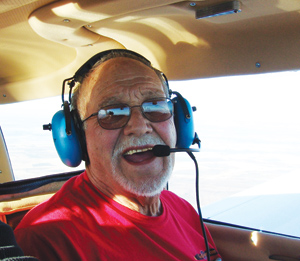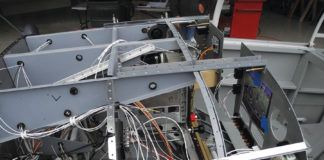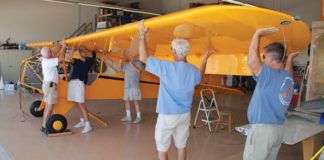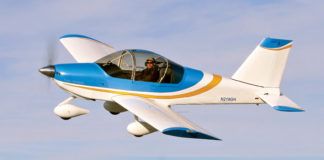No one who flies an airplane believes it is free of risk. Each of us works to minimize risk in his own way-it could be to never fly on a cloudy day, or refuse to board anything smaller than a Boeing. I have acquaintances who will not set foot in an Experimental airplane of any kind.
Within our group, we still have an improbably wide range of risk-taking attitudes, some of which are curious to me. I know pilots who want their engines as close to stock as possible because they believe any modification reduces reliability, but who will also indulge in low passes and impromptu aerobatics. Rationalization is a funny thing when it comes to risk. One man’s death-defying feat is another’s meh.

Bud Warren in the LS1-powered Ravin.
Elsewhere in this issue, you’ll see an appreciation of Bud Warren, who perished with his adult daughter in early May. He was flying a Ravin 500 with a Chevy LS1 V-8 conversion sporting one of his own Geared Drives propeller speed reduction units (PSRUs). He is said to have reported smoke in the cockpit and was apparently trying to return to the Conroe, Texas airport. The Ravin crashed a half mile short of the runway.
Before the anti-auto engine contingent steps up to say "I told you so," consider what we don’t know: basically everything except the airplane had control continuity (according to the NTSB). Partisans will try to blame the engine or the installation. But I also read this week of an RV-10 that had an engine fire followed by a hard landing in a field (the pilot walked away) as the result of leaving a fuel-pump fitting loose. Are we shaking our fingers at Van’s or Lycoming? No. We turn around and give the builder grief for the oversight.
By the nature of what he did, Bud Warren exposed himself to risk. No matter how thoughtful, intelligent, conservative or innovative he might have been, developing new aircraft products, particularly something as unforgiving as an engine installation, entails risk. In the heady postwar boom of civil aviation, when Continental, Franklin, Lycoming and others were developing the opposed aircraft engines we know today, there were failures left and right. Cylinders had to be reworked. Crankshafts changed. Cases beefed up. Camshafts re-profiled. Magnetos and carburetors redesigned. These experiences were part of a lengthy development process-and in some ways the engineers had it easy. The unrelenting pace of wartime research in piston engines was still fresh in the minds of these engineers, so hard lessons learned with a massive staff and substantial budget were carried forward into more modest development programs. Metallurgy had improved tremendously as had the tools to ground-test new designs. There were failures and setbacks, sure, but every account I’ve read of engine development during World War II reinforces the idea that America’s best and brightest were put to the task of creating engines that were both more powerful and more reliable. Few endeavors are as difficult.
In today’s market, with the major manufacturers working mostly to remember how to build these legacy engines properly or to develop new strategies to cope with the inevitable loss of leaded fuel, innovation comes from other sectors, including the homebuilt market. Bright minds, free of the cost and restriction of certification, are unleashed toward new solutions. But the price can be dear. Few of these entrepreneur/engineer types have the funding to do extensive ground testing or computer simulation. Just as in the early days of aviation, they must get to a working prototype with no other choice than to go see how it flies. Every new variable introduces the possibility of a failure, and it takes a special breed of engineer/tester/broad thinker to process flight data-good and bad-to arrive at a workable solution. What I saw of Bud Warren’s work had the look of a man who had correctly identified the challenges and worked tirelessly toward solutions.
The loss of Warren and his daughter and business partner, Phyllis Ridings, could be the end of his efforts to make the Chevy V-8 workable for aircraft unless someone with the right mindset, determination and a little bit of development money steps up. Seems like a long shot in today’s tight economy. I hope I’m wrong.
Departing the Pattern
The name of this column was established long before I arrived here in the last quarter of 2004, intended, no doubt, to evoke the image of the editor looking over the airport (magazine issue) from pattern altitude (the last possible moment in the production timeline). From this perch, he can comment on the contents of the issue or, as I have frequently done here, elaborate on a topic taken up elsewhere.
To continue the metaphor of the title, it’s time for me to make a call on the CTAF announcing a downwind departure.
After this issue, I am turning KITPLANES over to good, practiced hands. Mary Bernard, who is on her second stint at this magazine, has been an outstanding Managing Editor: clear headed, calm in the face of looming deadlines and recalcitrant computer software, always curious about this wonderful sport we call Experimental aviation. She will make an exceptional Editor. She’s joined by newly minted Associate Editor Abby Ventzke, with whom I worked at Petersen/eMap/Primedia-a publishing house that changed its name so often we could have used chalkboard business cards.
Execution is something we always hope to improve, but I’ve long been proud of and vigorously defended our editorial focus. While it might make good fiscal sense to chase into other markets for advertising and support for external projects-like, um, a big air show, perhaps?-we have largely resisted movement from our core subject. It’s true we had a brief flirtation with factory-built Light Sport Aircraft, and there was a time we were dazzled by the latest/greatest (and often awfully expensive) new models, but the core of what we cover today is where this magazine needs to focus its efforts, I believe. A broad approach doesn’t work for us. We need to speak intelligently and clearly to people who are building and flying homebuilt aircraft, and to welcome those who might join our ranks. We need to pay as much attention to affordable flying as we do to the shiny-shiny. Practical, hands-on features are our lifeblood.
I look back on the six and a half years of editing this title and am immensely proud of the work its staff and outside contributors have done. Our band of writers, from stalwarts such as Barnaby Wainfan and Jim Weir to our newest members in Roy Beisswenger, Paul Dye and Dean Sigler, to use the parlance of our time, just completely get it. It’s safe to say KITPLANES will only become stronger.

![]()
Marc Cook has been in aviation journalism for 23 years and in magazine work for more than 25. He is a 4400-hour instrument-rated, multi-engine pilot with experience in nearly 150 types. Hes completed two kit aircraft, an Aero Designs Pulsar XP and a Glastar Sportsman 2+2.




